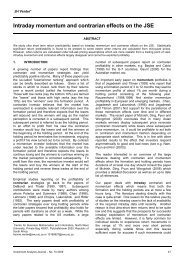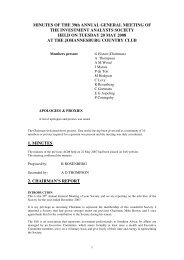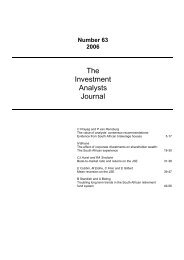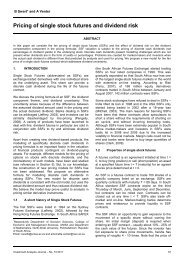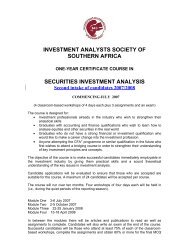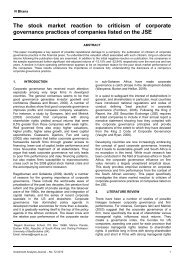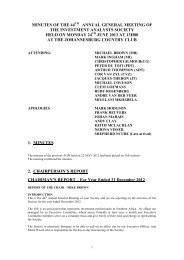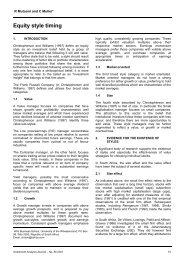Accounting is Broken - Investment Analysts Journal
Accounting is Broken - Investment Analysts Journal
Accounting is Broken - Investment Analysts Journal
Create successful ePaper yourself
Turn your PDF publications into a flip-book with our unique Google optimized e-Paper software.
Stern Stewart & Co.<br />
Transparency <strong>is</strong> not just<br />
about d<strong>is</strong>closing more<br />
data or even principally<br />
about that. It <strong>is</strong> chiefly<br />
about giving investors a<br />
clear window into how<br />
managers make or<br />
should make dec<strong>is</strong>ions<br />
that are in their best<br />
interests.<br />
The first step in the<br />
separation process <strong>is</strong> to<br />
measure profit before<br />
subtracting any financing<br />
charges. The result<br />
<strong>is</strong> known as net operating<br />
profit after taxes, or<br />
NOPAT for short.<br />
Unlike book net<br />
income, NOPAT <strong>is</strong> not<br />
affected by transitory<br />
shifts in capital structure<br />
or interest rates.<br />
The second step <strong>is</strong> to<br />
subtract all financing<br />
costs as re p resented by<br />
the strategic, weighted<br />
average cost of capital.<br />
The result <strong>is</strong> a popular<br />
method to measure economic<br />
profit that <strong>is</strong><br />
called EVA, or economic<br />
value added.<br />
WACC <strong>is</strong> the blended<br />
cost of all capital. It <strong>is</strong><br />
computed by weighting<br />
the after-tax cost of<br />
each capital component<br />
by its representation in<br />
an ideal capital structure<br />
mix.<br />
Regulators and other accounting authorities have a responsibly to relieve management of<br />
th<strong>is</strong> tension, and to conform GAAP accounting to the establ<strong>is</strong>hed principles and practices<br />
of value-based management. What’s needed <strong>is</strong> a new accounting standard that unites financial<br />
re p o rting with the capital budgeting techniques most companies now employ for internal<br />
re s o u rce allocation dec<strong>is</strong>ions. Tr a n s p a rency <strong>is</strong> not just about d<strong>is</strong>closing more data or<br />
even principally about that. It <strong>is</strong> chiefly about giving investors a clear window into how<br />
managers make or should make dec<strong>is</strong>ions that are in their best intere s t s .<br />
The recommended new accounting treatment <strong>is</strong> straightforw a rd. It <strong>is</strong> to put all of the operating<br />
results on one side of the economic profit calculation and then to subtract all financing<br />
costs on the other side:<br />
Economic Profit = Operating Results - The Cost of All Capital<br />
The first step in the separation process <strong>is</strong> to measure profit before subtracting any financing<br />
charges. The result <strong>is</strong> known as net operating profit after taxes, or NOPAT for short (a<br />
t e rm Joel Stern coined in the late 1960s following the seminal articles on corporate valuation<br />
theory by Nobel Laureates Merton Miller and Franco Modiglianni).<br />
N O PAT <strong>is</strong> a key measure of a company’s profit that accountants should d<strong>is</strong>close to investors.<br />
Unlike book net income, NOPAT <strong>is</strong> not affected by transitory shifts in capital stru c t u re or<br />
i n t e rest rates. It lets the sun shine through to reveal pure operating results. Dividing<br />
N O PAT by the sum total of a firm ’s debt and equity capital provides a rate of re t u rn you<br />
can take to the bank. It measures how productively management has managed capital<br />
re g a rdless of how it has financed the capital. It <strong>is</strong> far more reliable than re t u rn on equity as<br />
a bas<strong>is</strong> to compare a company’s perf o rmance from one year to the next or across a group of<br />
companies within the same year, because financing diff e rences are purg e d .<br />
Having removed financing costs from NOPAT, the second step <strong>is</strong> to subtract all financing<br />
costs as re p resented by the strategic, weighted average cost of capital. The result <strong>is</strong> a popular<br />
method to measure economic profit that <strong>is</strong> called EVA 6 , or economic value added:<br />
Economic Profit = NOPAT - The Cost of Debt and Equity<br />
E VA = NOPAT - (WACC% x $Total Capital)<br />
WACC <strong>is</strong> the blended cost of all capital. It <strong>is</strong> computed by weighting the after-tax cost of<br />
each capital component by its re p resentation in an ideal capital stru c t u re mix. Finance staff s<br />
c a refully select their target capital stru c t u re blends by balancing the benefit of using cheap<br />
debt financing against their need to pre s e rve financing flexibility and withstand downturn s<br />
with an equity cushion. Depending on the company, the ideal target capital stru c t u re mix<br />
usually runs in a range from about 20% debt and 80% equity for rapid growth high-tech<br />
f i rms to about 60% debt and 40% equity for mature, cash surplus generating ones. The<br />
t a rget capital stru c t u re <strong>is</strong> also one that management should be committed to attaining on<br />
average and over time.<br />
Once a firm ’s target capital stru c t u re <strong>is</strong> set, its weighted average cost of capital can be determined.<br />
To illustrate, recall the former example company that was employing $1 billion in<br />
equity capital. Suppose that the firm ’s management has establ<strong>is</strong>hed and <strong>is</strong> now maintaining<br />
its capital stru c t u re target cons<strong>is</strong>ting of two-thirds equity and one-third debt. If so, its $1<br />
billion in equity capital <strong>is</strong> currently augmented by $500 million in debt for a total capital<br />
base of $1.5 billion.<br />
6<br />
In a comprehensive EVA accounting system all financing costs should be backed out of NOPAT and impounded into the cost of<br />
capital in order to clearly and totally separate operating and financing dec<strong>is</strong>ions. For instance, off-balance sheet lease commitments<br />
should be d<strong>is</strong>counted to a present value and included as part of debt capital for the purpose of measuring the overall cost of capital,<br />
and the implied after-tax interest component of the annual rents should be added back to NOPAT. The debt and interest associated<br />
with Special Purpose Entities in which the company holds more than a 50% economic interest (including any debt capital<br />
that <strong>is</strong> secured by guarantees or derivative instruments) should also be brought into the firm ’s capital, cost of capital, and NOPAT<br />
calculation. Out of sight should not become out of mind.<br />
7




